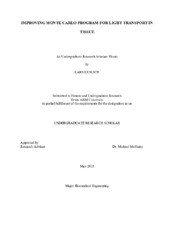| dc.description.abstract | Monte Carlo Simulations use random number generators and aggregation in order to numerically solve various real-world problems that are too difficult to solve analytically. They are currently the gold standard for simulating photon transport through tissues, and with the adoption of GPU computing, a program by the name of Monte Carlo eXtreme can run these simulations faster than ever. However, this program still lacks several features that would be useful to researchers, such as fluorescent material support and easy simulation of multiple wavelengths. I have added the multi-wavelength feature to MCX, and I have started the process of adding a feature that will allow researchers to easily model fluorescence materials. Although more testing is required, I have laid the foundations of a program that is more readily useful and robust while retaining the speed increases afforded by GPU computing. | en |


